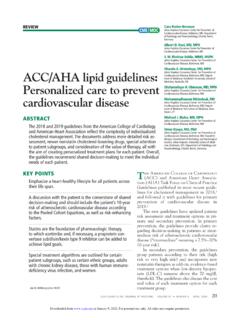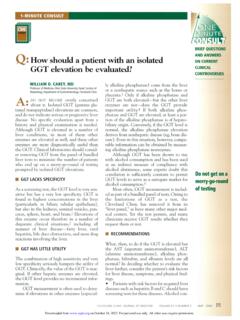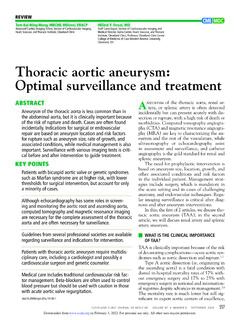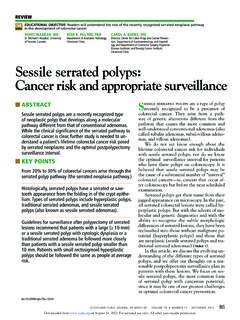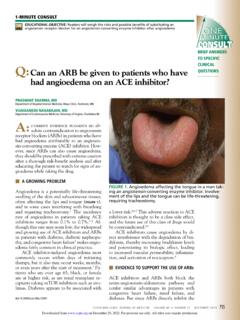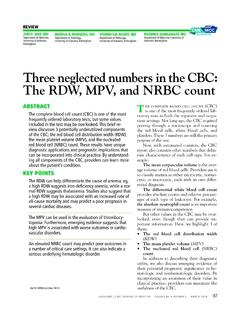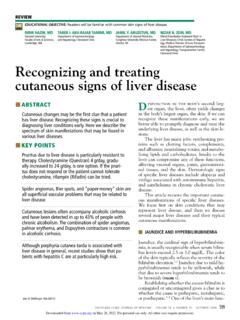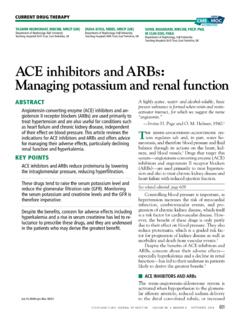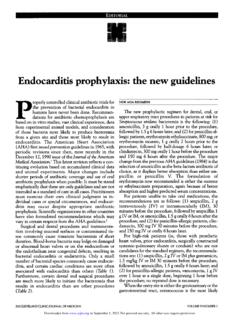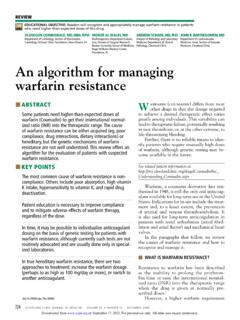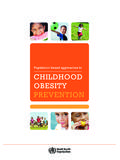Transcription of Sepsis and septic shock: Guideline-based management
1 Sepsis and septic shock: Guideline-based managementCLEVELAND CLINIC JOURNAL OF MEDICINE VOLUME 87 NUMBER 1 JANUARY 202053 Sepsis and particularly septic shock should be recognized as medical emergen-cies in which time matters, as in stroke and acute myocardial infarction. Early recognition and rapid institution of resuscitative measures are critical. But recognizing Sepsis can be a challenge, and best management practices continue to evolve. This article reviews guidance on the di-agnosis and management of Sepsis and septic shock, with attention to maximizing adher-ence to best practice statements, and contro-versies in defi nitions, diagnostic criteria, and management . COMMON AND LIFE-THREATENINGS epsis affects 750,000 patients each year in the United States and is the leading cause of death in critically ill patients, killing more than 210,000 people every About 15% of patients with Sepsis go into septic shock, which accounts for about 10% of admissions to intensive care units (ICUs) and has a death rate of more than 50%.
2 The incidence of Sepsis doubled in the United States between 2000 and 2008,2 pos-sibly owing to more chronic diseases in our aging population, along with the rise of anti-biotic resistance and the increased use of in-vasive procedures, immunosuppressive drugs, and chemotherapy. The cost associated with Sepsis -related care in the United States is more than $ billion DEFINITIONS HAVE EVOLVEDIn 1991, Sepsis was fi rst defi ned as a systemic infl ammatory response syndrome (SIRS) due is a life-threatening organ dysfunction that results from the body s response to infection. It requires prompt recognition, appropriate antibiotics, careful hemodynamic support, and control of the source of infection. With the trend in management moving away from protocolized care in favor of appropriate usual care, an understanding of Sepsis physiology and best practice guidelines is critical. KEY POINTST ools such as the Systemic Infl ammatory Response Syndrome criteria and the quick version of the Sequential Organ Failure Assessment can help with early diagnosis and triage.
3 The initial antibiotic should be broad-spectrum, based on local sensitivity patterns, with daily assessment of appro-priate antibiotic de-escalation and cessation. Resuscitation with initial fl uid boluses should be followed by weighing benefi ts and risks of additional fl uid admin-istration based on dynamically assessed volume status, and then aggressive fl uid removal during recovery. During resuscitation, a goal mean arterial pressure of 65 mm Hg is preferred, using norepinephrine (with vasopres-sin if needed) to achieve it. Glucocorticoids are not recommended if fl uid resuscita-tion and vasopressors are suffi cient to restore hemo-dynamic stability. Siddharth Dugar, MDDepartment of Critical Care, Respiratory Institute, Cleveland Clinic; Clinical Assistant Professor, Cleveland Clinic Lerner College of Medicine of Case Western Reserve University, Cleveland, OH Chirag Choudhary, MD, MBAD epartment of Critical Care, Respiratory Institute, Cleveland Clinic; Clinical Assistant Professor, Cleveland Clinic Lerner College of Medicine of Case Western Reserve University, Cleveland, OH Abhijit Duggal, MD, MPH, MSc, FACPD epartment of Critical Care, Respiratory Institute, Cleveland Clinic; Assistant Professor, Cleveland Clinic Lerner College of Medicine of Case Western Reserve University, Cleveland, OH on February 5, 2022.
4 For personal use only. All other uses require from 54 CLEVELAND CLINIC JOURNAL OF MEDICINE VOLUME 87 NUMBER 1 JANUARY 2020 Sepsis AND septic SHOCKto a suspected or confi rmed infection with 2 or more of the following criteria4: Temperature below 36 C or above 38 C heart rate greater than 90/minute Respiratory rate above 20/minute, or arte-rial partial pressure of carbon dioxide less than 32 mm Hg White blood cell count less than 4 109/L or greater than 12 109/L, or more than 10% bands. Severe Sepsis was defi ned as the progression of Sepsis to organ dysfunction, tissue hypoper-fusion, or hypotension. septic shock was described as hypotension and organ dysfunction that persisted despite volume resuscitation, necessitating vasoactive medication, and with 2 or more of the SIRS criteria listed above. In 2001, defi nitions were updated with clinical and laboratory In 2004, the Surviving Sepsis Campaign guidelines adopted those defi nitions, which led to the development of a protocol-driven model for Sepsis care used The US Centers for Medicare and Medicaid Services (CMS) followed suit, defi ning Sepsis as the presence of at least 2 SIRS criteria plus infec-tion; severe Sepsis as Sepsis with organ dysfunc-tion (including serum lactate > 2 mmol/L).
5 And septic shock as fl uid-resistant hypotension requiring vasopressors, or a lactate level of at least 4 In 2016, the Sepsis -3 committee8 issued the following new defi nitions: Sepsis A life-threatening condition caused by a dysregulated host response to infection, resulting in organ dysfunction septic shock Circulatory, cellular, and metabolic abnormalities in septic patients, presenting as fl uid-refractory hypotension requiring vasopressor therapy with asso-ciated tissue hypoperfusion (lactate > 2 mmol/L). The classifi cation of severe Sepsis was defi nitions create confusionBoth the CMS and international consen-sus defi nitions are currently used in clinical practice, with distinct terminology and dif-ferent identifi cation criteria, including blood pressure and lactate cutoff points. The CMS defi nition continues to recommend SIRS for Sepsis identifi cation, while Sepsis -3 uses se-quential organ failure assessment (SOFA) or the quick version (qSOFA) to defi ne Sepsis (described below).
6 This has led to confusion among clinicians and has been a contentious factor in the development of care protocols. TOOLS FOR IDENTIFYING HIGH RISK: SOFA AND qSOFASOFA is cumbersomeSOFA is an objective scoring system to de-termine major organ dysfunction, based on oxygen levels (partial pressure of oxygen and fraction of inspired oxygen), platelet count, Glasgow Coma Scale score, bilirubin level, creatinine level (or urine output), and mean arterial pressure (or whether vasoactive agents are required). It is routinely used in clinical and research practice to track individual and aggregate organ failure in critically ill But the information needed is burden-some to collect and not usually available at the bedside to help with clinical decision-making. qSOFA is Singer et al8 compared SOFA and SIRS and identifi ed 3 independent predictors of organ dysfunction associated with poor outcomes in Sepsis to create the simplifi ed qSOFA: Respiratory rate at least 22 breaths/minute Systolic blood pressure 100 mm Hg or lower Altered mental status (Glasgow Coma Scale score < 15).
7 A qSOFA score of 2 or more with a sus-pected or confi rmed infection was proposed as a trigger for aggressive treatment, includ-ing frequent monitoring and ICU admission. qSOFA has the advantage of its elements be-ing easy to obtain in clinical has limitationsAlthough qSOFA identifi es severe organ dys-function and predicts risk of death in Sepsis , it needs careful interpretation for defi ning Sepsis . One problem is that it relies on the clinician s ability to identify infection as the cause of organ dysfunction, which may not be apparent early on, making it less sensitive than SIRS for diagnosing early Also, preexisting chronic diseases may infl uence Appropriate antimicrobialsshould be started within an hourof recognizing Sepsis on February 5, 2022. For personal use only. All other uses require from CLEVELAND CLINIC JOURNAL OF MEDICINE VOLUME 87 NUMBER 1 JANUARY 2020 55 DUGAR AND COLLEAGUES accurate qSOFA and SOFA In addition, qSOFA has only been validated outside the ICU, with limited utility in pa-tients already admitted to an Studies have suggested that the SIRS cri-teria be used to detect Sepsis , while qSOFA should be used only as a triaging ,13 ANTIMICROBIAL THERAPYP rompt, broad-spectrum antibiotics Delay in giving appropriate antibiotics is asso-ciated with a signifi cant increase in mortality 16 Appropriate antimicrobials should be initiated within the fi rst hour of recognizing Sepsis , after obtaining relevant samples for cul-ture provided that doing so does not signifi -cantly delay antibiotic The initial antimicrobial drugs should be broad-spectrum, covering all likely pathogens.
8 Multidrug regimens are favored to ensure suffi -cient coverage, especially in septic shock. The empiric choice of antimicrobials should con-sider the site of infection, previous antibiotic use, local pathogen susceptibility patterns, im-munosuppression, and risk factors for resistant organisms. Double coverage for gram-negative organisms and for methicillin-resistant Staphy-lococcus aureus (MRSA) should be considered for patients with a high likelihood of infection with such Double gram-negative coverage may be appropriate when a high degree of suspicion exists for infection with multi-drug-resistant organisms such as Pseudo-monas or Acinetobacter. If a nosocomial source of infection is suspected to be the cause of sep-sis, anti-MRSA agents are recommended. Appropriate dosing is also important, as effi cacy depends on peak blood level of the drug and on how long the blood level remains above the minimum inhibitory concentration for the pathogen.
9 An initial higher loading dose may be the best strategy to achieve the therapeutic blood level, with further dosing based on consultation with an infectious dis-ease physician or pharmacist, as well as thera-peutic drug monitoring if Consider antifungalsThe last few decades have seen a 200% rise in the incidence of Sepsis due to fungal Antifungals should be considered for patients at risk, such as those who have had total parenteral nutrition, recent broad-spec-trum antibiotic exposure, perforated abdomi-nal viscus, or immunocompromised status, or when clinical suspicion of fungal infection is high. Risk factors for fungal infection in septic shock should trigger the addition of echino-candins or liposomal amphotericin B. Azoles are considered appropriate for hemodynami-cally stable De-escalation and early cessation Antibiotics are not harmless: prolonged use of broad-spectrum antibiotics is associated with antimicrobial resistance, Clostridium diffi cile infection, and even A robust de-escalation strategy is needed to balance an initial broad-spectrum approach.
10 A pragmatic strategy may involve starting with broad-spectrum antimicrobials, particu-larly in the setting of hypotension, and then rapidly de-escalating to an antimicrobial with the narrowest spectrum based on local sensi-tivity patterns. If the clinical course suggests the illness is not actually due to infection, the antibiotics should be stopped immediately. A rapid nasal polymerase chain reaction test for MRSA to guide de-escalation has been shown to be safe and to signifi cantly reduce empiric use of vancomycin and ,23 Antibiotic de-escalation should be dis-cussed daily and should be an essential com-ponent of daily A 7- to 10-day course or even shorter may be appropriate for most infections,24,25 although a longer course may be needed if source control cannot be achieved, in immunocompromised hosts, and in S aureus bacteremia, endocarditis, or fungal infections. FLUID RESUSCITATIONS epsis is associated with vasodilation, capil-lary leak, and decreased effective circulating blood volume, reducing venous return.
